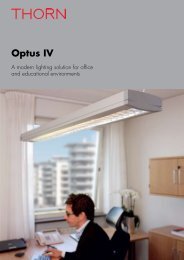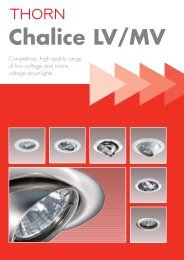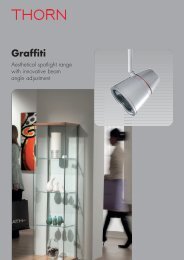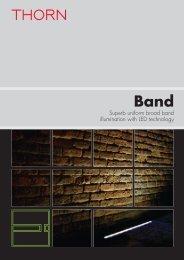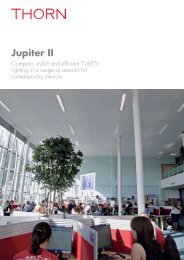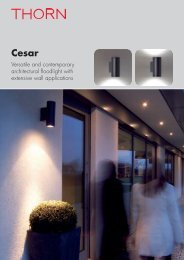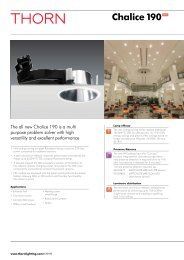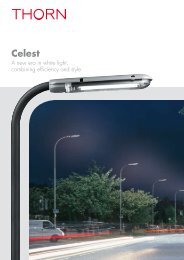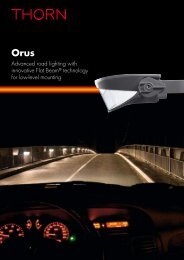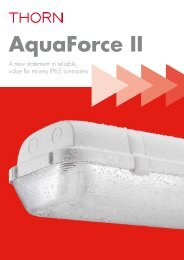SensaLink - Thorn Lighting
SensaLink - Thorn Lighting
SensaLink - Thorn Lighting
You also want an ePaper? Increase the reach of your titles
YUMPU automatically turns print PDFs into web optimized ePapers that Google loves.
<strong>SensaLink</strong><br />
Indoor <strong>Lighting</strong> Controls for interactive lighting<br />
in applications, requiring higher levels of comfort
Introduction<br />
<strong>Thorn</strong>’s Indoor <strong>Lighting</strong> Controls offer consists of three portfolios<br />
1 2 3<br />
1 SensaLite features <strong>Thorn</strong><br />
luminaires with built-in<br />
sensors, and remote sensors,<br />
offering stand-alone presence<br />
detection, daylight linking<br />
and infra-red control.<br />
SensaLite is the first step to<br />
comfort and energy saving,<br />
and is used for small office<br />
applications, simple<br />
classrooms, corridors etc.<br />
2 ControLiteDIM is used<br />
for mid-sized projects (1<br />
room): The modular system<br />
creates scene setting,<br />
enabling daylight linking<br />
and integrating presence<br />
detection. It is easy to<br />
commission by the contractor:<br />
When wiring the system, the<br />
luminaires are allocated to<br />
the switches, scene plates<br />
and presence detectors.<br />
3 <strong>SensaLink</strong> features <strong>Thorn</strong><br />
luminaires with built-in<br />
sensors and remote sensors<br />
offering presence detection,<br />
daylight linking and infra-red<br />
control, scene setting and<br />
the possibility to link sensors.<br />
It provides an interacting<br />
lighting management system<br />
for projects requiring greater<br />
levels of comfort.<br />
2
<strong>SensaLink</strong><br />
How does <strong>SensaLink</strong><br />
support the <strong>Thorn</strong> PEC<br />
strategy?<br />
Performance:<br />
<strong>SensaLink</strong> sets the right light<br />
level, at the right place and at<br />
the right time.<br />
Efficiency:<br />
<strong>SensaLink</strong> is a perfect tool<br />
to provide an efficient light.<br />
It enables you to dim the<br />
luminaires, link the luminaires<br />
to presence and link them to the<br />
incoming daylight to achieve<br />
energy saving. Therefore light<br />
is only provided when you<br />
need it and in the quantity that<br />
you require. <strong>SensaLink</strong> also<br />
continually adjusts its light output<br />
and energy input. This maintains<br />
illuminance over the entire<br />
period, saving the energy that<br />
conventional systems waste while<br />
fulfilling the objectives of many<br />
international and local lighting<br />
standards.<br />
Comfort:<br />
Manual dimming and presence<br />
detection are features of<br />
<strong>SensaLink</strong> that provide a<br />
comfortable lighting solution to<br />
the user. <strong>SensaLink</strong> is very easy to<br />
install and set up. By maintaining<br />
the illuminance level over the<br />
entire period, you will always<br />
have the same light level that you<br />
require. Therefore the lighting<br />
remains comfortable all of the<br />
time, without the need for regular<br />
and inconvenient re-adjustments.<br />
Additionally you can link several<br />
zones or rooms within an<br />
application that interact with<br />
one another.<br />
Where is <strong>SensaLink</strong> used?<br />
The typical applications for <strong>SensaLink</strong> are:<br />
<br />
comfort of scene setting, screen and blackout blind control, e.g.<br />
lecture theatres or conference rooms that divide into smaller and<br />
individually controlled areas.<br />
<br />
daylight and presence linked zones within each floor, e.g. open<br />
space offices, with the possibility to link the luminaires within<br />
these zones and adjacent areas.<br />
Features<br />
Applications<br />
Offices<br />
Conference<br />
rooms<br />
Lecture<br />
theatres<br />
Class rooms<br />
Dimming and Switching <br />
Presence-link <br />
Daylight-link <br />
Luminaires interacting<br />
with adjacent areas<br />
<br />
Distributed intelligence <br />
Scene setting <br />
Partition management<br />
<br />
Motorised Screen control <br />
Motorised Blackout blind control <br />
3
Overview of functions and their benefits<br />
Response to<br />
presence/absence<br />
<strong>SensaLink</strong> sensor heads provide<br />
presence linking that will detect<br />
you entering and leaving the<br />
<br />
to a pre-programmed level, and<br />
<br />
<br />
5 to 60mins. Additionally, the<br />
system offers a ‘semi-automatic’<br />
mode (absence detection),<br />
<br />
lighting manually (via a switch,<br />
a hand held controller or a<br />
scene plate), and the detector<br />
will switch or fade the lighting to<br />
<br />
left the room. Both cases give<br />
the possibility to dim the light to<br />
a minimum or a defined level<br />
<br />
Dimming response to<br />
incoming daylight<br />
<strong>SensaLink</strong> detectors provide<br />
a dimming facility that<br />
automatically adjusts the light<br />
level in response to the available<br />
daylight. You decide which light<br />
level the controlling sensor should<br />
maintain through the day, and<br />
if the sensor should switch the<br />
<br />
daylight.<br />
Switching response to<br />
incoming daylight<br />
Here, dedicated <strong>SensaLink</strong><br />
heads, with relay output, switch<br />
<br />
<br />
the ambient light level. These<br />
products come with an adjustable<br />
light level.<br />
Local override<br />
<br />
infra-red hand held controller<br />
to override sensors that are<br />
responding to the incoming<br />
daylight – very convenient,<br />
especially in larger office<br />
applications, where you want<br />
to change the lighting allocated<br />
to one desk only, or to a group<br />
of luminaires. It also allows<br />
recalling and setting six scenes<br />
for different tasks.<br />
<br />
either the <strong>SensaLink</strong> two button<br />
control plate or a momentary<br />
action switch for changing the<br />
light level and to switch the<br />
<br />
onto the wall next to the room<br />
entry, and therefore ideal for<br />
smaller sized areas.<br />
You are present. Insufficient daylight. Lights on.<br />
<br />
scene plate is a versatile<br />
interface for overriding the<br />
light within conference rooms<br />
or lecture theatres, allowing<br />
you to set and recall six scenes<br />
for the different activities (see<br />
‘Scene setting’).<br />
No-one present. Lights off.<br />
You remain present. Sufficient daylight. Lights dim.<br />
You enter the room. Lights switch on.<br />
You remain present. Bright daylight. Lights<br />
dimmed to minimum.<br />
4
Parameter setting for<br />
tailor-made functionality<br />
This portfolio uses an infrared<br />
programming tool to<br />
re-programme a wide range<br />
of parameters, and to set the<br />
regulating light level. This is<br />
particularly useful in that you are<br />
able to change the parameters<br />
without touching the installation,<br />
and is therefore fast, hassle-free<br />
and doesn’t disrupt the room<br />
users: The programming is done<br />
remotely and hence can be<br />
operated from the ground.<br />
Maintained<br />
illuminance level<br />
Light levels reduce over<br />
time due to lamp age and<br />
dirty optics. Conventional<br />
installations provide more<br />
light than is necessary to<br />
ensure that the right level is<br />
reached when depreciation is<br />
worst. This results in energy<br />
wastage and unnecessary<br />
cost. Being intelligent,<br />
the <strong>SensaLink</strong> detectors<br />
continually adjust the light<br />
output and energy input. This<br />
maintains illuminance over<br />
the entire period, saving the<br />
energy that conventional<br />
systems waste and fulfilling<br />
the objectives of many<br />
international and local<br />
lighting standards.<br />
Illuminance<br />
Maintenance interval<br />
Maintenance<br />
Illuminance in accordance<br />
with age and soiling of lamp<br />
Required normal illumuminance<br />
Energy savings through dimming<br />
of surplus capacity<br />
5
Overview of functions and their benefits<br />
Corridor<br />
Corridor<br />
Interaction between<br />
luminaires<br />
<strong>SensaLink</strong> allows sensors<br />
to be linked. In this way,<br />
sensors “listen” to each<br />
other and share information<br />
about presence/absence<br />
within their detection zones.<br />
This feature is useful for<br />
example in office applications;<br />
notional corridors, staircases,<br />
and lobbies can be set to<br />
remain lit as long as one of<br />
the sensors is detecting a<br />
presence, providing enough<br />
light in the surrounding areas<br />
and giving a feeling of safety<br />
(also known as ‘corridor hold’<br />
function).<br />
Interaction with room partitions<br />
Some applications require larger rooms to be divided into smaller<br />
separate rooms, depending on the activities. <strong>SensaLink</strong> detects if the<br />
rooms are separated or linked, and reacts accordingly: If the partition<br />
is closed, <strong>SensaLink</strong> provides individual control within each room. If<br />
the partition is opened, the combined rooms offer joined control.<br />
Corridor<br />
Reliability with<br />
decentralised functions<br />
<strong>SensaLink</strong> keeps local functions<br />
local. All parameters and<br />
settings for a specific sensor<br />
head are stored within the unit,<br />
therefore it will continue to<br />
function even if the Bus system<br />
it is connected to fails or is<br />
interrupted. The benefit is that<br />
presence and daylight-link, and<br />
local override functions are<br />
continuously provided, without<br />
the room user realising the loss<br />
of the Bus system.<br />
Upgrade ability<br />
As the <strong>SensaLink</strong> sensor heads<br />
are able to work “stand-alone”<br />
when they are not connected to<br />
a central Bus system (see also<br />
‘Reliability with decentralised<br />
functions’), the possibility arises<br />
to install them first, and to<br />
link them, via the <strong>SensaLink</strong><br />
Bus, in a second phase. By<br />
doing this, the functionality of<br />
the installation would initially<br />
be similar to several <strong>Thorn</strong><br />
SensaDigital installations,<br />
working independently from<br />
one another, and then in the<br />
second stage provide all the<br />
additional <strong>SensaLink</strong> functions.<br />
In existing <strong>SensaLink</strong><br />
installations the Bus system also<br />
allows you to add additional<br />
devices and to extend the<br />
system at anytime. This<br />
provides you with the flexibility<br />
that you would expect from a<br />
control system, adapting to the<br />
continuously changing needs,<br />
uses and room layouts within a<br />
building.<br />
6
Blackout blind and screen control<br />
<br />
blackout blinds and screens to be integrated within the different<br />
scenes. <strong>SensaLink</strong> provides this comfort<br />
Scene Setting<br />
For every activity or room use you can set up to six different scenes<br />
<br />
projection screens. This provides the comfort you expect for a lecture<br />
theatre, a conference room and other applications that are used in<br />
various ways. Typically Scene 1 is the daylight-linked one.<br />
Scene ‘Presentation’<br />
<br />
and daylight<br />
<br />
<br />
Scene ‘Lecture’<br />
<br />
digitally projected picture,<br />
but still giving enough light<br />
for auditorium to take notes<br />
<br />
<br />
<br />
podium<br />
Scene ‘Break’<br />
<br />
reactivate auditorium<br />
<br />
7
System topology and components<br />
1) Starting with a multi sensor head for each<br />
group of luminaires within an area…<br />
<strong>SensaLink</strong> responds to presence/absence by switching, and to<br />
daylight by dimming. Entering an area causes the lighting to come<br />
to a pre-programmed level and the luminaires automatically adjust<br />
depending on the natural light present.<br />
a) <strong>Thorn</strong> was among the first<br />
companies to offer intelligent<br />
luminaires:<br />
<br />
incorporate a miniature<br />
sensor capable of controlling<br />
electronic gears, transformers<br />
and phase dimmers via a DSI<br />
signal.<br />
<br />
Luminaire lies in the fact that<br />
it works as soon as you take<br />
it out of the box and install<br />
it to the ceiling. You can still<br />
<br />
standard mains switch, which<br />
also means you do not have to<br />
change an existing installation.<br />
<br />
are possible as well, where<br />
you connect further luminaires<br />
(‘slaves’) to the DSI output<br />
of the <strong>SensaLink</strong> Luminaire<br />
(‘master’). The maximum<br />
number of ballasts incorporated<br />
in all controlled luminaires<br />
must not exceed 4, and<br />
all luminaires should be in<br />
the detection zone of the<br />
Mini<strong>SensaLink</strong> head (diameter<br />
5m at nominal mounting<br />
height 2m above work plane,<br />
maximum mounting height 3m).<br />
<br />
Guides for <strong>Thorn</strong> <strong>SensaLink</strong> luminaires<br />
(containing ‘HFL’ in their descriptions). ‘Slave’<br />
luminaires for connection to the <strong>SensaLink</strong><br />
Luminaires are the standard DSI dimmable<br />
ones (containing ‘HFD’ in their descriptions).<br />
MenloSoft SR with built-in Mini<strong>SensaLink</strong> head<br />
BUS<br />
2m<br />
HFL<br />
HFD<br />
5m<br />
HFD<br />
HFD<br />
Optional ‘Master-slave’ luminaire<br />
arrangement (max. 4 DSI ballasts in total)<br />
Detection pattern<br />
b) Remote <strong>SensaLink</strong> sensor<br />
heads enable you to control a<br />
group of luminaires: instead<br />
of having a ‘master-slave’<br />
arrangement as described in<br />
a). These remote sensor heads<br />
are mounted to the ceiling<br />
and control a luminaire group<br />
incorporating up to 8 DSI ballasts<br />
each. These luminaires should<br />
be in the detection zone of the<br />
sensor head (diameter 6m at<br />
nominal mounting height 2.4m<br />
above work plane, maximum<br />
mounting height 3m). You have<br />
the choice between a recessed<br />
mounted version that is suitable<br />
for unobtrusive installation<br />
in suspended ceilings ref.<br />
<br />
a surface mounted version for<br />
all other types of ceilings ref.<br />
<br />
The sensor incorporates a DSI<br />
output that is connected to the DSI<br />
dimmable luminaires via a 2-pole<br />
polarity-free lead. The maximum<br />
length of the DSI lead between<br />
sensor heads and luminaires can<br />
be 12m, using standard mains<br />
wiring 2 x 1.5mm² with solid<br />
or stranded conductors, e.g.<br />
H05VV-U (harmonised standard<br />
300/500V cable, PVC insulated<br />
and sheathed, with solid<br />
conductors).<br />
Note: All standard <strong>Thorn</strong> DSI dimmable<br />
luminaires can be controlled via remote<br />
<strong>SensaLink</strong> heads: look for <strong>Thorn</strong><br />
luminaires containing ‘HFD’ in the<br />
<br />
Instead of controlling dimmable<br />
luminaires, there is also a<br />
recessed remote sensor head for<br />
switching fixed output luminaires,<br />
for a maximum load of 6A,<br />
considering inrush currents ref.<br />
<br />
This sensor is connected to<br />
the luminaires with standard<br />
mains wiring.<br />
Please refer to ‘Product parameters’<br />
for possible sensor settings.<br />
Please refer to ‘Product parameters’ for<br />
possible sensor settings.<br />
8
Recessed remote <strong>SensaLink</strong> head<br />
Surface mounted remote <strong>SensaLink</strong> head<br />
BUS<br />
HFD<br />
HFD<br />
25m<br />
HFD<br />
HFD<br />
6m<br />
Sensor connected to luminaire group<br />
(max. 8 DSI ballasts in total)<br />
Detection pattern<br />
N<br />
L<br />
D1<br />
D2<br />
DSI<br />
L<br />
N<br />
+<br />
BUS<br />
T<br />
+<br />
–<br />
BUS<br />
DSI<br />
D1<br />
D2<br />
Wiring recessed version<br />
Wiring surface mounted version<br />
9
System topology and components<br />
2) …linking these areas within rooms and floors…<br />
Within an application several<br />
of these individually controlled<br />
areas can now be linked via the<br />
<strong>SensaLink</strong> Bus. To accomplish this<br />
technically, a two-wire Bus (mains<br />
rated and unscreened twisted<br />
pair) runs from device to device,<br />
and a Bus power supply enables<br />
the devices to communicate with<br />
each other and share occupancy<br />
information. <strong>SensaLink</strong> provides a<br />
standard Bus power supply for up<br />
<br />
<br />
up to 200 <strong>SensaLink</strong> devices ref.<br />
<br />
The Bus wiring topology can<br />
be a ring with short spurs,<br />
radial or star like. The Bus lead<br />
may also run alongside mains<br />
wiring, provided that the Bus<br />
is suitably insulated. The mains<br />
topology is independent from the<br />
Bus topology, as the <strong>SensaLink</strong><br />
devices can be mains powered<br />
from different electrical circuits<br />
and phases.<br />
HFD<br />
HFD<br />
HFL<br />
HFD<br />
HFD<br />
HFD<br />
HFL<br />
HFD<br />
HFD<br />
HFD<br />
Example for radial bus topology; maximum length of each radial 500m (300m) with 1 5mm 2 (1.0mm 2 ) conductor size<br />
HFD<br />
HFD<br />
HFD<br />
HFD<br />
HFD<br />
HFD<br />
HFL<br />
HFD<br />
HFD<br />
HFD<br />
HFD<br />
HFD<br />
HFD<br />
HFD<br />
HFD<br />
HFD<br />
HFL<br />
HFD<br />
HFD<br />
HFD<br />
HFD<br />
HFD<br />
<strong>SensaLink</strong><br />
Bus<br />
Mains<br />
BUS<br />
Power Supply<br />
(LT or G)<br />
<strong>SensaLink</strong><br />
Bus<br />
For interconnecting all <strong>SensaLink</strong><br />
items a bus lead is used: The<br />
maximum length of this <strong>SensaLink</strong><br />
Bus can be up to 1500m (if wired<br />
as a ring), the cable should be<br />
1.5mm² twisted-pair unscreened.<br />
HFD<br />
HFD<br />
HFD<br />
HFD<br />
HFD<br />
HFD<br />
BUS<br />
Power Supply<br />
(LT or G)<br />
HFL<br />
HFD<br />
HFL<br />
HFD<br />
HFL<br />
HFD<br />
Mains<br />
HFD<br />
HFD<br />
HFD<br />
HFD<br />
HFD<br />
HFD<br />
HFL<br />
HFD<br />
Example for ring bus topology; maximum length of ring 1500m (800m) with 1 5mm 2 (1.0mm 2 ) conductor size<br />
Standard Bus power supply<br />
Bus power supply for larger applications<br />
10
3) …and connect these floors to a building backbone<br />
In larger applications requiring<br />
several of the larger Bus power<br />
<br />
<br />
99 of these Bus power supplies<br />
to a common spine or backbone<br />
(2 x 2 x 0.2mm 2 , twisted pair,<br />
screened communication cable,<br />
e.g. a RS-232 computer cable,<br />
maximum length 1200m). So<br />
with <strong>SensaLink</strong> large buildings<br />
can be catered for!<br />
HFD<br />
HFD<br />
HFD<br />
HFD<br />
HFL<br />
HFD<br />
HFD<br />
HFD<br />
HFL<br />
HFD<br />
HFD<br />
HFD<br />
<strong>SensaLink</strong> Bus<br />
Mains<br />
BUS<br />
Power Supply<br />
(G only)<br />
Mains<br />
BUS<br />
Power Supply<br />
(G only)<br />
Spine<br />
<strong>SensaLink</strong> Bus<br />
Mains<br />
BUS<br />
Power Supply<br />
(G only)<br />
<strong>SensaLink</strong> Bus<br />
Max 99<br />
supplies<br />
Mains<br />
BUS<br />
Power Supply<br />
(G only)<br />
11
System topology and components<br />
4) User interfaces<br />
Though a properly commissioned system will provide<br />
the right light for most of the time, occasionally you<br />
require more or less light. <strong>SensaLink</strong> offers you the<br />
accurate user interfaces for the different applications.<br />
Infra-red Hand held Controller<br />
Scene Select Plate, polished chrome finish<br />
Local Control Plate<br />
An Infra-red Hand held Controller<br />
enables you to dim and brighten,<br />
<br />
lighting: You have the choice<br />
between changing the light<br />
level locally and changing the<br />
light level of the group(s) your<br />
luminaires are allocated to. This<br />
Infra-red Hand held Controller<br />
is ideal for meeting rooms and<br />
other applications that are used<br />
in different ways, as it provides<br />
the facility to set and to recall 6<br />
scenes for the different activities<br />
<br />
For lecture theatres, conference<br />
rooms and other applications<br />
with the main focus on scene<br />
setting, <strong>SensaLink</strong>’s wall-mounted<br />
Scene Select Plate is the<br />
appropriate interface. It provides<br />
<br />
scenes and for dimming and<br />
brightening. All buttons endow<br />
<br />
you the current setting at any<br />
time. To match the Scene Select<br />
Plate to different wall<br />
materials and colours, it is<br />
available in polished brass,<br />
polished chrome, brushed<br />
stainless steel and white finish,<br />
<br />
<br />
<br />
The Local Control Plate allows<br />
<br />
to dim and brighten a group of<br />
<br />
<br />
12
5) Comissioning Tool 6) DSI and switching outputs,<br />
blind and screen control,<br />
switch inputs and interface<br />
to other systems<br />
Digital Programmer<br />
Universal Bus Transceiver<br />
<strong>Thorn</strong> commissioning engineers set up <strong>SensaLink</strong> installations; this<br />
service is offered together with the luminaires and the <strong>SensaLink</strong> items.<br />
There is also the possibility to train contractors and facility managers<br />
on site, looking after the project later as well. Whoever commissions,<br />
reconfigures or changes <strong>SensaLink</strong> installations, uses the <strong>SensaLink</strong><br />
<br />
group them, to allocate control units to the groups and to define all the<br />
interactions between the <strong>SensaLink</strong> devices. It is also used to configure<br />
<br />
time and many others. Additionally it can be used to copy data from<br />
one head and to use it for other ones. This device features a large LCD<br />
screen to make it easy to use. And due to communicating via infra-red<br />
with all the <strong>SensaLink</strong> devices, the commissioning can happen locally<br />
and from the ground: This makes the work easy and safe, and does<br />
not disrupt any room users during reconfigurations.<br />
<br />
multi-functional and provides several features:<br />
<br />
incorporating up to 20 DSI ballasts, e.g. in an area where luminaires<br />
do not need to be linked to presence or daylight.<br />
<br />
output luminaires (with magnetic or electronic gears) and non-lighting<br />
loads, e.g. screens and blackout blind motors, to be brought into the<br />
<strong>SensaLink</strong> installation.<br />
<br />
switch inputs into the system, e.g. from an external switch, timer, fire<br />
alarm system or BMS, and can be configured to recall a specific<br />
<br />
All <strong>SensaLink</strong> sensors can be allocated to Global Groups: This<br />
grouping structure is of less consideration to building users, but is<br />
of great importance for facility management, as it enables central<br />
and external systems to override all sensor heads allocated to a<br />
Global Group. The <strong>SensaLink</strong> Transceiver is used as the interface to<br />
these central systems: These could be central switches, or switching<br />
Building Management Systems (BMS) or timers. Global Group<br />
addressing is typically used for load shedding, security, night and<br />
other functions.<br />
Sensor heads and <strong>SensaLink</strong> Transceiver inputs may be allocated to<br />
one of two possible Global Groups, or to both if required.<br />
<br />
system now knows if the rooms are separated or linked, and reacts<br />
accordingly: If the partition is closed, <strong>SensaLink</strong> provides individual<br />
control within each room. If the partition is opened, the combined<br />
rooms offer joined control.<br />
13
Support of building compliance with European standards<br />
Office example, fully and partly occupied<br />
500lx<br />
500lx<br />
300lx<br />
300lx<br />
<strong>SensaLink</strong> supports<br />
your project to comply<br />
with EN 12464<br />
<br />
Norm 12464 differs from the<br />
classical approach in which the<br />
lighting design objective was<br />
to achieve average illuminance<br />
throughout the room. Next to<br />
many other criteria, the new<br />
standard on the one hand<br />
allows lighting designers greater<br />
freedom and designs that are<br />
more in line with the needs of<br />
individuals, and on the other<br />
defines that lighting must be<br />
delivered in the location where<br />
people perform their visual<br />
tasks. Different maintained<br />
illuminance levels apply for<br />
the different work places, and<br />
the surrounding areas where<br />
visual tasks are performed<br />
less often. For example for<br />
a 500lx task illuminance the<br />
immediate surround illuminance<br />
can drop down to 300lx.<br />
<strong>SensaLink</strong> maintains the specified<br />
illuminance levels, and also<br />
checks for you which areas are<br />
actually needed and occupied,<br />
and adapts the light output for<br />
the unoccupied, but surrounding<br />
areas, according to the standard.<br />
<strong>SensaLink</strong> supports<br />
your project to comply<br />
with EN 15193<br />
This standard establishes<br />
conventions and procedures<br />
for the estimation of energy<br />
requirements of lighting in<br />
buildings. It also provides<br />
guidance on the establishment of<br />
notional limits for lighting energy<br />
derived from reference schemes<br />
and gives advice on techniques<br />
for separate metering of the<br />
energy used for lighting that will<br />
give regular feedback on the<br />
effectiveness of lighting controls.<br />
Annex D (that is informative)<br />
recommends that (depending on<br />
the application) an area within<br />
one room, if it is illuminated<br />
by a luminaire or by a group<br />
of luminaires (manually or<br />
automatically) switched together,<br />
should not be larger than 30m 2 .<br />
In addition, in the case of systems<br />
with automatic presence and/<br />
or absence detection the area<br />
covered by the detector should<br />
closely correspond to the area<br />
illuminated by the luminaires that<br />
are controlled by that detector.<br />
As lighting controls system based<br />
on a network of multi sensor<br />
heads, <strong>SensaLink</strong> is the ideal<br />
tool to realise the recommended<br />
way of linking luminaires to<br />
daylight and presence/absence<br />
for each area within a room,<br />
and therefore will support good<br />
energy ratings for your building.<br />
14
Product parameters<br />
To adapt <strong>SensaLink</strong> to the local requirements, several parameters can<br />
be set within each multi sensor head or <strong>SensaLink</strong> luminaire. These are<br />
selected during commissioning, and can be easily copied from one<br />
head to the other to keep the commissioning time as short as possible.<br />
Power-up Condition<br />
When mains power is first<br />
applied, sensor heads either<br />
<br />
<br />
<br />
for up to 30s before looking<br />
<br />
<br />
corridors and access routes,<br />
<br />
other areas reduces the start-up<br />
load following any interruption<br />
in supply.<br />
Operation Mode<br />
Set for automatic operation,<br />
the sensor head switches<br />
<br />
automatically. In semi-automatic<br />
mode (also called “absence<br />
mode”), luminaires remain<br />
<br />
<br />
either via an user interface<br />
(e.g. the Infra-red hand held<br />
Controller) or when another<br />
head, part of the same zone, is<br />
<br />
Start Lamps<br />
When detecting presence, lamps<br />
<br />
maximum or minimum level,<br />
before ramping to the level the<br />
daylight-link calculates, or the<br />
level set one for a recalled scene.<br />
When Vacant<br />
<br />
above) has elapsed, lighting<br />
can either be set to…<br />
Entry Scene<br />
Any one of the 6 available<br />
scenes can be chosen to be<br />
activated when presence is<br />
detected. As scene 1 is the<br />
daylight-linked scene, this is the<br />
<br />
Dimming Range<br />
The daylight-link provided by<br />
a <strong>SensaLink</strong> sensor head will<br />
regulate over the full dimming<br />
range of the ballast’s capacity<br />
(typically between 100 and<br />
1%), to save as much energy as<br />
possible. In certain instances a<br />
minimum light level can be set,<br />
avoiding the light level going<br />
below a certain percentage.<br />
Set Light Level<br />
The luminaires are brightened<br />
or dimmed until the desired<br />
illuminance level is achieved. This<br />
level is stored using the <strong>SensaLink</strong><br />
Programmer. For luminaires with<br />
dimming ballasts, any lighting<br />
level within the operating range<br />
of the luminaire may be set. The<br />
system automatically compensates<br />
for lamp deterioration and<br />
luminaire condition, and<br />
continually adjusts its light output<br />
and energy input. This maintains<br />
illuminance over the entire<br />
period, saving the energy that<br />
conventional systems waste and<br />
fulfilling the objectives of many<br />
international and local lighting<br />
standards.<br />
Bright-out<br />
Lights can be programmed to<br />
<br />
conditions, and to save even<br />
more energy. If Bright-out is not<br />
selected, the luminaire will simply<br />
remain at minimum light output<br />
until occupancy ceases or the<br />
daylight contribution decreases.<br />
Off Delay<br />
This is the time between the last<br />
detected occupancy, and when<br />
the lighting automatically is<br />
changed to the chosen ‘When<br />
<br />
Delay options are 5 to 60min<br />
(in 5min steps), several hours,<br />
and 10s for test purposes during<br />
commissioning.<br />
Fade to Off<br />
<br />
luminaires dim very slowly (the<br />
fade rate is 4min/100%) before<br />
<br />
recommended in open-plan office<br />
<br />
cause distraction.<br />
<br />
sensor heads, provide some<br />
further parameters, which are<br />
detailed in the datasheets.<br />
Following the installation of<br />
<strong>SensaLink</strong>, the commissioning of<br />
the system and the setting of its<br />
parameters is carried out locally<br />
using the hand-held infra-red<br />
<strong>SensaLink</strong> Programmer. Settings<br />
can be checked at any time. And<br />
if the requirements for lighting<br />
change, the parameters set<br />
during commissioning can be<br />
reconfigured quickly and easily.<br />
...switch off...<br />
<br />
...go to minimum output... <br />
...continue with daylight-link, but with maximum 25% output... <br />
...go to scene 6 (and therefore to a specified output)... <br />
...until next occupancy<br />
...for 3 hours and then<br />
switch off<br />
...and switch off after<br />
the whole building is<br />
vacant<br />
15
Interactive lighting<br />
S<br />
Open space<br />
C<br />
‘listening’<br />
BUS 1<br />
BUS 1<br />
S<br />
S<br />
S<br />
S<br />
C<br />
S<br />
S<br />
Corridor<br />
(could also be<br />
a notional one)<br />
S<br />
S<br />
S<br />
S<br />
C<br />
S<br />
S<br />
C<br />
C<br />
Sensor Group<br />
Within a room or space, sensor heads can be allocated to Sensor<br />
Groups:<br />
<br />
Sensor Group, are thus activated as soon as one of the sensor heads<br />
detects presence.<br />
<br />
<br />
‘When Vacant’ setting).<br />
<br />
of the Infra-red Handheld Controller or any other user interface<br />
allocated to this Sensor Group as well.<br />
<br />
open space office, or an auditorium area within a larger lecture<br />
theatre, sharing occupancy info and manual overrides.<br />
<br />
<br />
Groups: This feature enables to create overlapping areas if required.<br />
Common Group = Listening Sensor Group<br />
Sensor heads can alternatively be allocated to so-called Common<br />
Groups:<br />
<br />
other sensor heads within a <strong>SensaLink</strong> installation supplied by the<br />
same <strong>SensaLink</strong> Bus Power Supply.<br />
<br />
instead of a Sensor Group, will delay deactivating until there is<br />
vacancy in all areas.<br />
<br />
and notional corridors within open spaces, e.g. as shown in the<br />
<br />
Sensor Groups within the open space detects presence.<br />
<br />
also detects absence, the sensor heads within the Common Group<br />
<br />
<br />
see also Building Group).<br />
<br />
be allocated to up to 4 different Common Groups.<br />
Sensor heads are allocated either to a (standard)<br />
Sensor Group, or to a (listening) Common Group.<br />
16
C ‘1’<br />
BUS 1<br />
Luminaire connected to sensor<br />
Sensor allocated to:<br />
S<br />
S<br />
BUS 2<br />
Spine<br />
S<br />
S<br />
Sensor Group 1<br />
Sensor Group 2<br />
C<br />
S<br />
C<br />
C<br />
Sensor Group 1 and 2<br />
Common/Building Group 1<br />
Common Group 2<br />
S<br />
S<br />
C<br />
Common/Building Group1<br />
(in another bus district)<br />
BUS<br />
Bus power supply<br />
(Global one if linked via spine)<br />
Listening<br />
C<br />
S<br />
S<br />
C<br />
C<br />
C<br />
C<br />
Main corridors on different levels with staircase<br />
Building Group = Common Group 1<br />
The Common Group number 1 is a special one:<br />
<br />
Global Bus Power Supplies, are linked to a common spine, then this<br />
Common Group is shared within all bus districts building wide.<br />
<br />
17
Application: lecture theatre<br />
Specification example:<br />
<br />
area lighting controlled<br />
individually<br />
<br />
presenter’s area to adapt<br />
theatre to different uses<br />
<br />
to entrance to override rear<br />
area lighting if requested<br />
<br />
(when scene 1 is activated)<br />
daylight-linked<br />
<br />
blinds integrated<br />
<br />
linked with presence and<br />
theatre lighting<br />
How it works:<br />
<br />
luminaires within the lecture<br />
theatre (Specline Alpha HFD)<br />
are connected to remote<br />
<strong>SensaLink</strong> sensor heads,<br />
here with a maximum of 4<br />
luminaires per sensor head.<br />
<br />
<br />
not connected to a sensor<br />
head, but uses a <strong>SensaLink</strong><br />
Transceiver’s DSI output.<br />
<br />
opening the blackout blinds<br />
are controlled via the switched<br />
outputs of two Transceivers.<br />
<br />
raising a projection screen<br />
at the front of the theatre is<br />
connected to a switched output<br />
of a Transceiver as well.<br />
<br />
lit by downlights (Cruz HFD),<br />
these are connected to remote<br />
<strong>SensaLink</strong> sensor heads.<br />
<br />
together with the whiteboard<br />
lighting are allocated to three<br />
different Sensor Groups: All<br />
three groups show different<br />
illuminance levels when a scene<br />
is recalled. Within Sensor<br />
Group 1 (front area) and within<br />
Sensor Group 2 (rear area)<br />
information regarding presence<br />
is shared.<br />
<br />
projection screen form a<br />
separate Sensor Group 4:<br />
Within the scenes they are<br />
either closed/lowered (ideal for<br />
presentations e.g. using digital<br />
projectors) or opened/raised.<br />
<br />
Plate, recessed wall mounted<br />
near to the theatre entrance<br />
is allocated to Sensor Group<br />
2, and therefore enables the<br />
auditorium users to override the<br />
rear area lighting if required.<br />
<br />
Scene Select Plate is provided,<br />
also recessed wall mounted<br />
next to the presenting area: It is<br />
allocated to all Sensor Groups<br />
within the theatre (1 to 4) and<br />
provides the possibility to recall<br />
six different scenes including<br />
lights, blinds and screen. Scene<br />
1 is the daylight-linked one.<br />
<br />
Common Sensor Group, that<br />
“listens“ to all other (standard)<br />
Sensor Groups within the same<br />
bus district: As long as the<br />
S<br />
M<br />
S<br />
M<br />
Mains<br />
<strong>SensaLink</strong> BUS<br />
S<br />
S<br />
S<br />
DSI<br />
S<br />
M<br />
S<br />
S<br />
S<br />
S<br />
Projection<br />
Screen<br />
C<br />
Mains+DSI<br />
C<br />
C<br />
18
lecture theatre is occupied, the<br />
corridor and staircase light<br />
<br />
whole area is unoccupied.<br />
<br />
connected to the <strong>SensaLink</strong><br />
Bus, that is powered by the<br />
<strong>SensaLink</strong> Bus Power supply.<br />
<br />
several Global Bus Power<br />
Supplies connected to a<br />
building spine, the shown<br />
Common Group 2 could be<br />
the Building Group of another<br />
bus district (and would then<br />
be addressed as Common<br />
Group 1), sharing occupancy<br />
data with e.g. the corridor and<br />
staircase lighting in all other<br />
bus districts.<br />
Devices<br />
Recessed luminaire (e.g. Specline Alpha HFD)<br />
Whiteboard luminaire (e.g. Optus IV HFD)<br />
Recessed downlights (e.g. Cruz HFD)<br />
M<br />
Screen/Blackout blind motor 230V AC<br />
Sensor head<br />
Scene select plate, allocated to<br />
S<br />
S<br />
S<br />
S<br />
Local control plate, allocated to<br />
S<br />
Transceiver (used as DSI or Motor output)<br />
Bus power supply<br />
<strong>SensaLink</strong> Bus wire*<br />
Mains wire*<br />
DSI wire*<br />
DSI + mains wire*<br />
*Standard mains wiring 1.5mm2 with solid or<br />
stranded conductors, e.g. H05VVU<br />
S<br />
S<br />
S<br />
S<br />
C<br />
C<br />
Addresses<br />
Senor allocated to:<br />
Sensor Group 1 (front luminaires)<br />
Sensor Group 2 (rear luminaires)<br />
Sensor Group 3 (whiteboard luminaire)<br />
“Sensor” Group 4 (blackout blinds and screen)<br />
Common Group 1 (corridor and upper staircase)<br />
Common Group 2 (lower staircase etc.)<br />
Listening<br />
19
Application: open space office<br />
Specification example:<br />
<br />
daylight-linked<br />
<br />
corridor and common zone,<br />
overrides possible via infra-red<br />
hand held controllers<br />
<br />
with textile blind and meeting<br />
table, with 6 scenes recalled<br />
via infra-red hand held<br />
controller to adapt room to<br />
different uses<br />
<br />
and kitchen<br />
<br />
linked with presence and<br />
office lighting<br />
How it works:<br />
<br />
fluorescent luminaires within<br />
the open space are <strong>SensaLink</strong><br />
luminaires containing a built-in<br />
Mini<strong>SensaLink</strong> head (MenloSoft<br />
SR HFL). The other half are<br />
standard dimmable luminaires<br />
(MenloSoft SR HFD), connected<br />
to the DSI output of the<br />
<strong>SensaLink</strong> ones. Within these<br />
master-slave installations, one<br />
Mini<strong>SensaLink</strong> head can control<br />
a maximum of 4 DSI ballasts<br />
in total.<br />
<br />
connected to the <strong>SensaLink</strong><br />
Bus; the slave luminaires are<br />
connected to the masters via<br />
a Mains/DSI lead.<br />
<br />
numbers are used to group<br />
the luminaires above different<br />
desk areas.<br />
<br />
arrangements can also be<br />
found in the manager’s office,<br />
grouped into two separate<br />
groups as this room is used<br />
by the manager in two ways,<br />
either when working at the<br />
desk, or when holding a<br />
meeting in the other half of<br />
the room.<br />
<br />
opening the textile blind in<br />
front of the manager’s office’s<br />
window is controlled via the<br />
switched output of a <strong>SensaLink</strong><br />
Transceiver, that is addressed<br />
with an own Sensor Group<br />
number: Within the scenes the<br />
blind is either closed (ideal<br />
when sun shines directly into<br />
the room) or opened.<br />
<br />
room, for the copy machine<br />
and the kitchen, are lit by<br />
downlights (Cruz HFD), these<br />
are connected to remote<br />
<strong>SensaLink</strong> sensor heads.<br />
<br />
<strong>SensaLink</strong> luminaire.<br />
<br />
Common Sensor Group, that<br />
listens to all other (standard)<br />
Sensor Groups within the same<br />
Bus district: As long as one of<br />
the desks, or the manager’s<br />
office, or the kitchen is<br />
occupied, the lobby light<br />
Mains<br />
<strong>SensaLink</strong> Bus<br />
Mains+ Bus<br />
S<br />
S<br />
S<br />
S<br />
S<br />
Mains<br />
+ DSI<br />
S<br />
M<br />
S<br />
C C C<br />
S<br />
S<br />
S<br />
S<br />
C<br />
C<br />
S<br />
S<br />
C<br />
C<br />
20
whole area is unoccupied.<br />
<br />
corridor between the desks<br />
and leading to the other<br />
areas, is commissioned as a<br />
Common Sensor Group as<br />
well, and holds the light until<br />
all <strong>SensaLink</strong> luminaires and<br />
sensor heads within the whole<br />
area are reporting vacancy.<br />
<br />
presence and daylight-linked.<br />
<br />
from scene 1 is recalled in the<br />
manager’s office, is the room’s<br />
daylight-link deactivated.<br />
<br />
hand held controllers to set<br />
scenes or to brighten and dim<br />
the light, one is on her/his<br />
desk, the other on the<br />
meeting table.<br />
<br />
receptionist have infra-red hand<br />
held controllers reachable.<br />
To dim or brighten the light,<br />
they aim the controllers to one<br />
of the built-in Mini<strong>SensaLink</strong><br />
heads. The controllers show 2<br />
pairs of dim buttons, one is for<br />
overriding the light output of<br />
all luminaires connected to the<br />
targeted sensor head, the other<br />
pair is for overriding the whole<br />
Sensor Group or Common<br />
Group, the sensor head is<br />
part of.<br />
<br />
connected to the <strong>SensaLink</strong><br />
Bus, that is powered by the<br />
<strong>SensaLink</strong> Bus Power supply.<br />
<br />
<strong>SensaLink</strong> Bus wire is partly<br />
installed as ring and partly<br />
as spur.<br />
Devices<br />
Addresses<br />
Recessed luminaire (e.g. MenloSoft SR HFD)<br />
Sensor allocated to:<br />
S<br />
Recessed luminaire with built-in Mini<strong>SensaLink</strong><br />
head (e.g. MenloSoft SR HFL)<br />
S<br />
S<br />
S<br />
S<br />
S<br />
Sensor Group 1 to 5 (<strong>SensaLink</strong> luminaires in open<br />
space, above desks)<br />
S<br />
Suspended luminaire (e.g. Sienna HFD)<br />
Suspended luminaire with built-in Mini<strong>SensaLink</strong><br />
head (e.g. Sienna HFL)<br />
C<br />
Common Sensor Group 1(<strong>SensaLink</strong> luminaires in<br />
open space, above notional corridors and<br />
common area)<br />
M<br />
Recessed downlights (e.g. Cruz HFD)<br />
Blind motor 230V AC<br />
Remote Sensor Head recessed mounted<br />
S S<br />
S<br />
Sensor Groups 6 and 7 (<strong>SensaLink</strong> luminaires in<br />
manager’s office)<br />
“Sensor” Group 8 (textile blind in manager’s office)<br />
Infrared hand held controller<br />
S<br />
Sensor Group 9 (remote <strong>SensaLink</strong> head in<br />
separate room/kitchen)<br />
Transceiver (used as Motor output)<br />
S<br />
Sensor Group 10 (<strong>SensaLink</strong> luminaire in lobby,<br />
above desk)<br />
Bus power supply<br />
C<br />
Common Group 2 (remote <strong>SensaLink</strong> head in lobby)<br />
<strong>SensaLink</strong> Bus wire**<br />
Mains wire*<br />
Listening<br />
<strong>SensaLink</strong> Bus**+Mains wire*<br />
DSI wire*<br />
DSI+Mains wire*<br />
*Standard mains wiring 1.5mm 2 with solid<br />
or stranded conductors, e.g. H05VV-U<br />
**Mains rated wiring 1.5mm 2 , twisted pair,<br />
with solid or stranded conductors, e.g. H05VV-U<br />
21
Detailed overview on all products and accessories<br />
96102982 SENSALINK MRE SENLDDSI<br />
Passive Infra-red (PIR) detector and photocell, responds to presence/absence and to light by dimming or<br />
switching off. They can control HFD luminaires incorporating up to 8 DSI ballasts, and can be used in<br />
<br />
<br />
ceiling (max. height 3m, max. thickness 54mm, hole diameter 50mm, ceiling void 125mm). Detection zone<br />
radius 6m at 2.4m ceiling height. DSI lead 2-wire digital polarity-free, max. length 12m. <strong>SensaLink</strong> Bus<br />
unscreened twisted pair 1.5mm², polarity-conscious. Photocell; adjusted when commissioned, regulation<br />
deactivated when one of the Scenes 2 to 6 is recalled. Degree of protection IP40. Dimensions Ø 65mm,<br />
<br />
230VAC.<br />
96013500 SENSALINK MSF SENLDDSI<br />
Passive Infra-red (PIR) detector and photocell, responds to presence/absence and to light by dimming or<br />
switching off. Can control luminaires incorporating up to 8 DSI ballasts, and can be used in conjunction<br />
<br />
<br />
Detection zone radius 6m at 2.4m ceiling height. DSI 2-wire digital polarity-free, max. length 12m.<br />
<strong>SensaLink</strong> Bus unscreened twisted pair 1.5mm², polarity-conscious. Photocell; adjusted when commissioned,<br />
regulation deactivated when one of the Scenes 2 to 6 is recalled. Degree of protection IP53. Dimensions<br />
<br />
Luminaires with built-in Mini<strong>SensaLink</strong> head<br />
To see which standard <strong>Thorn</strong> luminaires are <strong>SensaLink</strong> enabled,<br />
<br />
Guides. If you cannot find one within your selected luminaire range,<br />
please contact your sales office.<br />
96100101 SENSALINK MRE SENLDSW<br />
Passive Infra-red (PIR) detector and photocell, responds to presence/absence and to light by switching<br />
luminaires on and off. Switched live output to operate standard luminaires with magnetic or fixed output HF<br />
circuits, for a maximum load of 6A, considering inrush currents, can be used in conjunction with an<br />
<br />
ceiling (max. height 3m, max. thickness 54mm, hole diameter 50mm, ceiling void 125mm). Detection<br />
zone radius 6m at 2.4m ceiling height. <strong>SensaLink</strong> Bus unscreened twisted pair 1.5mm², polarity-conscious.<br />
Photocell: adjusted when commissioned, switching regulation deactivated when one of the Scenes 2 to 6 is<br />
recalled. Degree of protection IP40. Dimensions Ø 65mm, height 115mm, weight 0.07kg excluding lead.<br />
<br />
22
96102983 SENSALINK SENLP<br />
Programmer used to commission a <strong>SensaLink</strong> system. The programmable parameters of the various products<br />
(e.g. illuminance level, time delay to switch off, start-up level, fading, operation mode (auto or semi-auto),<br />
addresses and many more) can be configured via this battery-powered, hand held, infra-red unit. The<br />
programmer allows commissioning and re-commissioning to be carried out with virtually no disturbance to<br />
the building’s occupants, as programming is done remotely and therefore can be operated from the ground.<br />
Settings are chosen from the menu and transferred instantaneously to the product being programmed by<br />
pressing the Upload button. The commissioning engineer receives positive feedback at all stages of the<br />
process. Settings from one product can be copied in seconds to another and settings can be checked at any<br />
time using the download function. Display 128 x 64 monochrome LCD display. Supply voltage 3 alkaline<br />
batteries, type AAA. Dimensions 150x 85x35mm, weight approx. 0.23kg.<br />
96232304 SENSALINK SENLPS LT<br />
Bus Power Supply unit provides the signalling highway for up to 100 <strong>SensaLink</strong> devices. Bus interconnection<br />
cable 1 to 1.5mm², unscreened twisted pair, installed either as radial or ring (may be run with mains<br />
cabling): For radial Bus topology, maximum length of each radial is 500m (300m) with 1.5mm 2 (1.0mm 2 )<br />
conductor size. For ring Bus topology, maximum length of ring is 1500m (800m) with 1.5mm 2 (1.0mm 2 )<br />
conductor size. A centre-off retractive switch can be additionally connected to the ‘Wall Switch’ Common<br />
and Up/Down terminals: This enables to dim, brighten and to switch on and off all <strong>SensaLink</strong> devices<br />
allocated to Sensor Group 1 and 2 within the supplied bus district. Dimensions: 125x175x75mm, weight:<br />
0.12kg. Mounted in ceiling or on wall.<br />
96232305 SENSALINK SENLPS G<br />
Bus Power Supply provides the signalling highway for up to 200 <strong>SensaLink</strong> devices. Bus interconnection<br />
cable 1 to 1.5mm², unscreened twisted pair, installed either as radial or ring (may be run with mains<br />
cabling): For radial Bus topology, maximum length of each radial is 500m (300m) with 1.5mm 2 (1.0mm 2 )<br />
conductor size. For ring Bus topology, maximum length of ring is 1500m (800m) with 1.5mm 2 (1.0mm 2 )<br />
conductor size. In larger applications with more than 200 <strong>SensaLink</strong> devices, up to 99 of these Bus<br />
power supplies can be linked to a common spine or backbone (2x2x0.2mm 2 , twisted pair, screened<br />
communication cable, e.g. a RS-232 computer cable, maximum length 1200m). With the spine the<br />
Common Sensor Group 1 becomes a Building Group, providing building wide linking of all Common<br />
Groups 1 within the different Bus districts. Three pairs of switch input terminals enable central control: With<br />
<br />
<br />
open switch connected to ‘Load Shed 1’ or ‘Load Shed 2’ all <strong>SensaLink</strong> devices allocated to Global Group<br />
<br />
<br />
<br />
flash when several of these Bus Power Supplies are connected together and Building Group (Common<br />
Sensor Group 1) linking occurs. Supply voltage 230VAC. Dimensions 213x185x117mm. Degree of<br />
protection IP65. Mounted adjacent to the mains distribution board for the area being controlled.<br />
23
96102981 SENSALINK SENLRC<br />
Infra-red hand held Controller provides user with local override facility, allows to select preferred light levels<br />
<br />
targeted to a <strong>SensaLink</strong> luminaire or multi sensor head. The controller shows 2 pairs of dim buttons, one is<br />
for overriding the light output of all luminaires connected to the targeted sensor head, the other pair is for<br />
overriding the whole Sensor Group or Common Group, the sensor head is part of. Additionally it enables to<br />
set and recall six scenes for the different activities in a room via 6 small buttons. Supply voltage 2 alkaline<br />
<br />
96237037 SENSALINK SENLSS V2<br />
Six scenes can be recalled by depressing the appropriate button “1” to “6” on the Scene Select Plate,<br />
<br />
individually using the <strong>SensaLink</strong> Infra-red hand held Controller, and then one of the scene buttons is pressed<br />
and held until the luminaires flash to confirm the setting. Additionally the scene plate provides buttons with<br />
<br />
for <strong>SensaLink</strong> Bus unscreened twisted pair 1.5mm², polarity-conscious. IR port for interfacing with <strong>SensaLink</strong><br />
<br />
double back box (not supplied) for sinking in (min. box depth 30mm) or dry-line plasterboard walls. Supply<br />
voltage 230VAC.<br />
96237037 plus 96237039<br />
Cover plate (size 85 x 145mm) ordered separately:<br />
96237038 SENSALINK SENLSS V2 BR POL COVER<br />
Metal cover polished brass finish for <strong>SensaLink</strong> Scene Select Plate Version 2<br />
96237039 SENSALINK SENLSS V2 CHR POL COVER<br />
Metal cover polished chrome finish for <strong>SensaLink</strong> Scene Select Plate Version 2<br />
96237040 SENSALINK SENLSS V2 RS BS COVER<br />
Metal cover brushed stainless steel finish for <strong>SensaLink</strong> Scene Select Plate Version 2<br />
96237041 SENSALINK SENLSS V2 WHI COVER<br />
Metal cover white finish for <strong>SensaLink</strong> Scene Select Plate Version 2<br />
96218671 SENSALINK WHI MWA SENLCP<br />
<br />
luminaires. Can be allocated to one Sensor Group number via ‘dip’ switches. Supplied via <strong>SensaLink</strong> Bus<br />
(consumes 2 bus loads). Connection for <strong>SensaLink</strong> Bus unscreened twisted pair 1.5mm², polarity-conscious.<br />
<br />
<br />
30mm) or dry-line plasterboard walls.<br />
96013499 SENSALINK SENLT<br />
<strong>SensaLink</strong> Universal Bus Transceiver provides a DSI output for controlling dimmable luminaires incorporating<br />
up to 20 DSI ballasts, a switching relay output (maximum load 10A) for switching fixed output luminaires<br />
(with magnetic or electronic gears) and non-lighting loads, e.g. screens and blackout blind motors.<br />
Additionally features inputs for external devices, e.g. external switches, timers, BMS outputs. Is also used<br />
for room partitions, enabling individual control within two rooms when a partition is closed, and joined<br />
control of the combined rooms when the partition is opened. Supply voltage 230VAC.<br />
Dimensions 175x125x75mm, weight 0.12kg. Mounted in ceiling or on wall.<br />
24
22154307 PDAX 500VA<br />
Phase dimmer/Reverse phase dimmer (automatic load detection), controllable via any DSI output, for<br />
continuous dimming of ohmic light sources, LV halogen lamps with magnetic or electronic transformers.<br />
A total connected load of 40 to 500VA can be operated. Dimming range 1...100%. Connection via screw<br />
terminals, housing made of flame-resistant polycarbonate – halogen-free, suited for luminaire installation or<br />
ceiling recess, admissible ambient temperature of 0...60°C (max. 300VA)/0...45°C (max. 500VA).<br />
Degree of protection IP20. Size 167x42x31mm. Weight 200g.<br />
22154306 PDAS 1000VA<br />
Phase dimmer/Reverse phase dimmer (automatic load detection), controllable via any DSI output for<br />
continuous dimming of ohmic light sources, LV halogen lamps with magnetic or electronic transformers. A<br />
total connected load of 40 to 1000VA can be operated. Dimming range 1...100%. Connection via screw<br />
terminals, housing made of flame-resistant polycarbonate - halogen-free, suitable for installation in switch or<br />
distribution cabinets on 35mm DIN rail. Permitted ambient temperature 0...40°C. Degree of protection IP20.<br />
Width 105mm (6 units), height 90mm, depth 59mm. Weight 400g.<br />
86457873 TE one4all sc 105VA<br />
Digital, dimmable transformer with DSI/DALI interface; controllable via any DSI or DALI output, dimming<br />
range of 1%…100%; for operation of 12V low voltage tungsten-halogen lamps with a lamp power of<br />
between 20 and 105VA; lamp leads up to 2m; housing made of flame-resistant polycarbonate, halogenfree;<br />
suitable for luminaire installation; protection class II; ambient temperature –25…+60°C. Size<br />
167x42x31mm. Weight 180g.<br />
86457874 TE one4all sc 150VA<br />
Digital, dimmable transformer with DSI/DALI interface; controllable via any DSI or DALI output, dimming<br />
range of 1%…100%; for operation of 12V low voltage tungsten-halogen lamps with a lamp power of<br />
between 20 and 150VA; lamp leads up to 2m; housing made of flame-resistant polycarbonate,<br />
halogen-free; suitable for luminaire installation; protection class II; ambient temperature –20…+50°C.<br />
Size 207x46x40mm. Weight 290g.<br />
25
Ordering Guide<br />
Description<br />
SAP code<br />
Description<br />
SAP code<br />
Multisensor head with DSI output recessed mounted<br />
Scene Select Plate and Covers<br />
96102982<br />
Multisensor head with DSI output surface mounted<br />
96013500<br />
Multisensor head with switched output recessed mounted<br />
96100101<br />
Programmer<br />
96102983<br />
Bus Power Supplies, global and lite<br />
96232305<br />
96232304<br />
Infrared Hand held Controller<br />
96102981<br />
96237037<br />
96237038<br />
96237039<br />
96237040<br />
96237041<br />
Local Control Plate including cover<br />
96218671<br />
Universal Transceiver<br />
96013499<br />
Accessories / DSI/DALI transformer, 12V, 20-105VA and 50-150VA<br />
86457873<br />
86457874<br />
Accessories / DSI phase or reverse phase dimmer, auto load detection,<br />
40-500VA and 40-1000VA<br />
PDAX 500VA 22154307<br />
PDAS 1000VA 22154306<br />
Energy efficiency<br />
Annual Energy Costs<br />
- Application example<br />
Classrooms<br />
<br />
when you consider the number<br />
of rooms within a building and<br />
the difference between old and<br />
new lighting technologies. As<br />
an example: The comparison<br />
between 1970’s classrooms<br />
and those of today (with and<br />
without daylight-linking) clearly<br />
shows significant cost savings are<br />
available. The example is based<br />
on a typical 1970 classroom<br />
lighting installation of nine fittings<br />
each with 2x40W T38 lamps and<br />
magnetic gear, compared to a<br />
typical 2009 classroom of nine<br />
fittings each with 1x35W T16<br />
lamp and electronic gear, and<br />
finally the same modern classroom<br />
with the dimmable versions of<br />
the same luminaires linked to the<br />
incoming daylight using <strong>SensaLink</strong><br />
(maintenance based on 16000<br />
hours, 2480 hours use per annum<br />
with varying lighting durations<br />
based on time of day).<br />
Cost of Energy (£/year)<br />
300000<br />
250000<br />
200000<br />
150000<br />
100000<br />
50000<br />
0<br />
Classroom Annual Energy Costs (9p/kWh)<br />
0 3 6 9 12 15 18 21 24<br />
Number of classrooms<br />
Key<br />
9 luminaires,<br />
2x40W T38,<br />
magnetic gear<br />
9 luminaires,<br />
1x35W T16,<br />
electronic gear<br />
9 luminaires,<br />
1x35W T16,<br />
dimmable<br />
electronic gear,<br />
linked to<br />
incoming daylight<br />
26
<strong>Lighting</strong> people and places<br />
<strong>Thorn</strong> <strong>Lighting</strong> Limited<br />
UK<br />
Silver Screens, Elstree Way, Borehamwood,<br />
Hertfordshire, WD6 1FE<br />
UK Sales desk -<br />
Orders/Stock Enquiries<br />
Tel: 0844 855 4810<br />
Fax: 0844 855 4811<br />
Ireland<br />
<strong>Thorn</strong> <strong>Lighting</strong> (Ireland) Limited<br />
Century House<br />
Harolds Cross Road<br />
Dublin 6W<br />
Tel: (353) 1 4922 877<br />
Fax: (353) 1 4922 724<br />
E-mail: dublinsales@thornlighting.com<br />
<strong>Thorn</strong> Olympics Sports <strong>Lighting</strong> Team<br />
Tel: 07785 251 438<br />
E-mail: olympics.team@thornlighting.com<br />
Spare Parts<br />
Tel: 0191 301 3131<br />
Fax: 0191 301 3038<br />
E-mail: spares@thornlighting.com<br />
Technical Support<br />
Tel: 0844 855 4812<br />
Fax: 020 8732 9882<br />
E-mail: technical@thornlighting.com<br />
Brochureline Answering Service<br />
Brochures on specific products/ranges<br />
Tel: 020 8732 9898<br />
Fax: 020 8732 9899<br />
E-mail: brochures.uk@thornlighting.com<br />
www.thornlighting.co.uk<br />
<strong>Thorn</strong> <strong>Lighting</strong> is constantly developing and improving its products. All descriptions, illustrations,<br />
drawings and specifications in this publication present only general particulars and shall not form<br />
part of any contract. The right is reserved to change specifications without prior notification or<br />
public announcement. All goods supplied by the company are supplied subject to the company’s<br />
General Conditions of Sale, a copy of which is available on request. All measurements are in<br />
millimetres and weights in kilograms unless otherwise stated.<br />
Publication No: 428 (GB) Publication Date: 09/09<br />
Member of The <strong>Lighting</strong><br />
Industry Federation<br />
ISO 9001:2000<br />
Reg: 2916/0<br />
Manufacturing & Distribution




